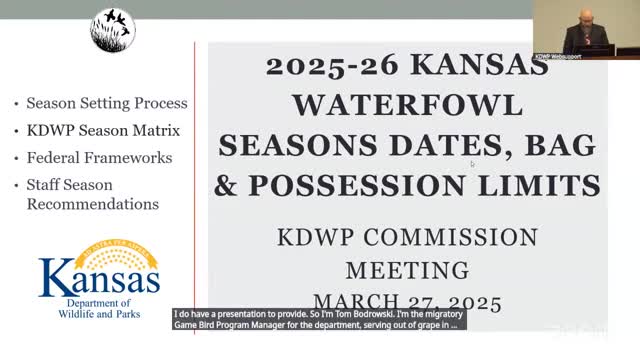Kansas Wildlife and Parks reviews 2025 waterfowl seasons and bag limits
March 27, 2025 | Department of Wildlife & Parks, State Agencies, Organizations, Executive, Kansas
Thanks to Scribe from Workplace AI , all articles about Kansas are free for you to enjoy throughout 2025!

This article was created by AI using a video recording of the meeting. It summarizes the key points discussed, but for full details and context, please refer to the video of the full meeting. Link to Full Meeting
One of the primary topics was the adjustment of the September teal season, which will see a reduction from 16 days to 9 days due to a decline in the blue-winged teal breeding population. This change marks the first reduction in the Kansas low plains season since 2006. The KDWP staff recommended adopting federal frameworks for daily bag limits and shooting hours, ensuring that Kansas aligns with national standards while also considering local hunting practices.
The meeting also highlighted the importance of incorporating hunter feedback into the decision-making process. A recent survey indicated that a majority of waterfowl hunters preferred an increase in the daily bag limit for geese from 6 to 8, a recommendation that KDWP plans to implement. This change aims to enhance hunting opportunities while maintaining sustainable population levels.
In addition to these adjustments, the KDWP discussed the structure of duck hunting zones and season splits, which are reviewed every five years. The current zoning system allows for tailored hunting experiences across different regions of the state, accommodating the diverse preferences of Kansas hunters. This flexibility is crucial for maximizing hunting opportunities and aligning season dates with the migration patterns of various waterfowl species.
The meeting concluded with a commitment to transparency and stability in the season-setting process, with final decisions expected to be made at the upcoming April commission meeting. These discussions reflect KDWP's ongoing efforts to balance ecological considerations with the recreational needs of the community, ensuring that Kansas remains a prime destination for waterfowl hunting. As the state prepares for the upcoming seasons, the KDWP continues to prioritize the voices of local hunters while adhering to federal guidelines.
Converted from KDWP Commission Meeting - Thursday, March 27, 2025 meeting on March 27, 2025
Link to Full Meeting
Comments
View full meeting
This article is based on a recent meeting—watch the full video and explore the complete transcript for deeper insights into the discussion.
View full meeting
